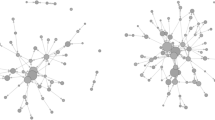Abstract
Hypotheses from diffusion and resource dependence theory are applied to the explanation of participation in external networking (inter-networking) by schools. A national probability sample of 571 U.S. K-12 schools was used to test factors predicting schools’ use of external networks for instructional purposes. Early (vs late) adoption of computers did not predict later involvement in networking. Neither school spending nor rural region predicted network participation, except through the intervening variable of computer density. Thus, no matter how a school has acquired computers, once the base has been established it serves as an essential ingredient in taking the next step into external networking. The results were disappointing for diffusion theory and certainly point toward further investigation of this phenomenon. The findings also point to the importance of building a technological infrastructure in order to boost and leverage many of the instructional reform initiatives in education.
Similar content being viewed by others
References
Albrecht, Gary L. 1979. “Defusing Technological Change in Juvenile Courts.”Sociology of Work and Occupations 6, 3 (August): 259–282.
Anderson, Robert L. and David J. Ortineau. 1988. “Exploring Consumers Attitudes and Use Behaviors in Monitoring the Diffusion of a Technology-based Discontinuous Innovation.”Journal of Business Research 17: 283–298.
Anderson, Ronald E. (Ed). 1993.Computers in American Schools 1992: An Overview. Minneapolis, MN: IEA Computers in Education Study, 909 Social Sciences Bldg, University of Minnesota.
Anderson, Ronald E. 1995. Estimates of Hardware in American Schools, (memo) Minneapolis, MN: IEA Computers in Education Study, 909 Social Sciences Bldg, University of Minnesota.
Brancheau, James. 1987. “The Diffusion of Information Technology: Testing and Extending Innovation Diffusion Theory in the Context of EndUser Computing.” Ph.D. dissertation, Department of Management Sciences, University of Minnesota, MN.
Cohen, D.K. 1988. “Educational Technology and School Organization.” In R.S. Nickerson, ed.Technology and Education: Looking toward 2020. Hillsdale, NJ: Erlbaum.
Coleman, J., E. Katz, and H. Menzel. 1957. “The Diffusion of an Innovation among Physicians.”Sociometry, 20:253–270.
Danko, W.D. and J.M. MacLachlan. 1983. “Research to Accelerate the Diffusion of a New Innovation: The Case of Personal Computers.”Journal of Advertising Research. 23:39–43.
Dickerson, M.D. and J.W. Gentry. 1983. “Characteristics of Adopters and Non-adopters of Home Computers.”Journal of Consumer Research. 10:225–235.
Dutton, William H., Patrick Sweet, and Everett M. Rogers. 1989. “Socioeconomic Status and the Early Diffusion of Personal Computing in the United States.”Social Science Computer Review 7,3 (Fall): 259–271.
Gatignon, H. and T.S. Robertson. 1985. “A Propositional Inventory for New Diffusion Research.”Journal of Consumer Research 11: 398–409
Hawkins, Jan. 1993. “Technology and the Organization of Schooling.”Communications of the ACM 36,5 (May), 30–35.
Hunter, B. (forthcoming) “Learning and teaching on the Internet: Contributing to Educational Reform.” In Keller, James, ed. Public Access to the Internet. Cambridge, MA: JFK School of Government, Harvard University.
IEA. 1995. IEA Computers in Education Study, USA, Codebooks. Minneapolis, MN: IEA Computers in Education Study, 909 Social Sciences Bldg, University of Minnesota.
Magnan, Shon. 1993. “The Educational Computing Infrastructure.” In R.E. Anderson, ed.Computers in American Schools 1992: An Overview. Minneapolis, MN: IEA Computers in Education Study, Department of Sociology, University of Minnesota.
McQuarrie, Edward F. 1989. “The Impact of a Discontinuous Innovation: Outcomes Experienced by Owners of Home Computers.”Computers in Human Behavior 5:227–240.
Means, Barbara. 1994. “Introduction: Using Technology to Advance Educational Goals.” in Means, Barbara, ed.Technology and Education Reform: The Reality Behind the Promise. San Francisco, CA: Jossey-Bass Publishers.
National Center for Educational Statistics (NCES). 1995.Advanced Telecommunications in U. S. Public Schools, K-12. (Preliminary report of the 1994 Fast Response Survey) Washington DC: NCES, U.S. Department of Education.
Pelgrum, Willem J., and Tjeerd Plomp. 1991.The Use of Computers in Education Worldwide. Elmsford, NY: Pergamon Press.
Pelgrum, Willem J. and Tjeerd Plomp (Editors). 1993.The IEA Study of Computers in Education: Implementation of an Innovation in 21 Education Systems. Elmsford, N.Y.: Pergamon Press.
Pfeffer, J. 1978.Organizational Design. Arlington Heights, IL: AHM Publishing Co.
Rogers, Everett M. 1983.Diffusion of Innovations (3rd ed.). New York: The Free Press.
Rogers, Everett M. and R. Agarwala Rogers. 1976.Communications in Organizations. New York: Free Press.
Rogers, Everett M. and F. Shoemaker. 1971.Communications of Innovations: A Cross-Cultural Approach. New York: Free Press.
Tuijnman, Albert C. and Alfons C. A. ten Brummethuis. 1993. “Predicting Computer Use in Six Systems: Structural Models of Implementation Indicators.” In Pelgrum, Willem J. and Tjeerd Plomp, eds.The IEA Study of Computers in Education: Implementation of an Innovation in 21 Education Systems. Oxford, England: Pergamon Press.
U.S. Congress. (1988)Power on! New tools for teaching and learning. (OTA-SET-379 Office of Technology Assessment) Washington, D.C.: U.S. Government Printing Office.
Venkatraman, Meera P. 1991. “The Impact of Innovativeness and Innovation Type on Adoption.”Journal of Retailing 67, 1: 51–67.
Zaltman, Gerald, Robert Duncan, and Jonny Holbek. 1973.Innovations and Organizations. New York: John Wiley and Sons.
Author information
Authors and Affiliations
Corresponding author
Additional information
where he has been since completing his Ph.D. at Stanford University in 1970. His primary specialty has been computing: developing computer-related methods in sociology as well as doing research on the social aspects of information technology. Shon Magnan is a Ph.D. candidate in sociology at the University of Minnesota and a research analyst at Questar Data Systems in Eagan Minnesota.
This material is based on work supported by the National Science Foundation under grant number SED-9154511. Any opinions, findings, and conclusions expressed in this article do not necessarily reflect those of the National Science Foundation.
Rights and permissions
About this article
Cite this article
Anderson, R.E., Magnan, S.M. The adoption of external networking by American schools. Am Soc 27, 55–64 (1996). https://doi.org/10.1007/BF02691997
Issue Date:
DOI: https://doi.org/10.1007/BF02691997




